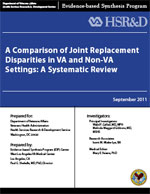
|
Principal Investigator: Walid F. Gellad, MD, MPH and Melinda Maggard Gibbons, MD, MSHS Evidence-based Synthesis Program (ESP) Center
West Los Angeles VA Medical Center Washington (DC): Department of Veterans Affairs; September 2011 |
Download PDF: Complete Report, Executive Summary, Report, Appendices
The leading cause of disability in the United States is osteoarthritis. There is no known cure. Consequently, osteoarthritis is managed with a variety of treatments to reduce disability, improve function, and alleviate symptoms. When conservative treatments fail, surgical intervention is indicated. The most effective surgical option for moderate to severe osteoarthritis in the knee or hip is total joint replacement (TJR). TJR is often considered appropriate in cases where other non-surgical treatments have not brought adequate relief. TJR in the management of end-stage osteoarthritis is widely utilized and is considered the fastest growing elective surgery in the nation, if not the world.
Although TJR is highly successful at treating advanced kip or knee osteoarthritis, there is substantial evidence that disparities exist in TJR utilization in non-VA settings, with racial and ethnic disparities being the most documented. This report compares what is known about disparities in TJR in the VA context with disparities in non-VA settings.